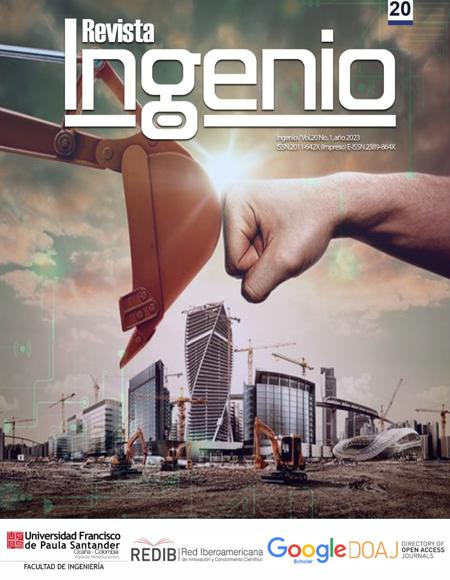Simulación numérica de la producción de hollín en una llama laminar de difusión axisimétrica de propano
Numerical simulation of soot formation in a propane axisymmetric laminar diffusion flame
Contenido principal del artículo
En este trabajo se realiza el estudio computacional de la formación de hollín para una llama de propano. Estas simulaciones, se
realizaron teniendo en cuenta el efecto del uso de parámetros como, la velocidad del flujo y el flujo masico por unidad de área, para
la predicción de la formación de hollín. También se tienen en cuenta parámetros como la altura de llama y la temperatura. En el
presente artículo se utiliza la herramienta computacional Fire Dynamics Simulator (FDS) para observar el comportamiento de la
producción de hollín en una llama laminar de difusión de propano (C3H8). En particular, se comparan los resultados de este software
con (a) datos experimentales presentados dentro de la literatura y (b) con las aproximaciones Large Eddy Simulation (LES) y Direct
Numerical Simulation (DNS), las cuales se emplean para predecir parámetros como, la producción de hollín, altura de llama y la
temperatura de llama alcanzada. Los resultados obtenidos muestran un buen comportamiento frente a los resultados experimentales.
Descargas
Detalles del artículo
A. J. Cardona-Vargas, C. Echeverri-Uribe, J. Zapata-López, J. Jaramillo-Álvarez, C. Arrieta-Gónzalez, y A. Amell-Arrieta, “Cálculo de propiedades de combustión y análisis de estabilidad de llama para el gas límite 65%CH4 + 35%H2”, Revista Ingenio, vol. 17, n.o 1, pp. 1–8, ene. 2020. Doi: https://doi.org/10.22463/2011642X.232.
H. A. Yepes-Tumay y A. Cardona-Vargas, “Influence of high ethane content on natural gas ignition”, Revista Ingenio, vol. 16, n.o 1, pp. 36–42, ene. 2019. Doi: https://doi.org/10.22463/2011642X.238.
R. Henríquez, R. Demarco, J. L. Consalvi, F. Liu, and A. Fuentes, “The oxygen index on soot production in propane diffusion flames,” in Combustion Science and Technology, May 2014, vol. 186, no. 4–5, pp. 504–517. Doi: https://doi.org/10.1080/00102202.2014.883226.
K. T. Kang, J. Y. Hwang, S. H. Chung, and W. Lee, “Soot zone structure and sooting limit in dif- fusion flames: Comparison of counterflow and co-flow flames,” Combustion and Flame, vol. 109, no. 1–2, pp. 266–281, Apr. 1997. Doi: https://doi.org/10.1016/S0010-2180(96)00163-0.
Y. Zhang, H. Zhou, M. Xie, Q. Fang, and Y. Wei, “Modeling of soot formation in gas burner using reduced chemical kinetics coupled with CFD code,” Chinese Journal of Chemical Engineering, vol. 18, no. 6, pp. 967–978, 2010. Doi: https://doi.org/10.1016/S1004-9541(09)60155-5.
I. M. Kennedy, “Models of soot formation and oxidation,” Progress in Energy and Combustion Science, vol. 23, no. 2, pp. 95–132, Jan. 1997. Doi: https://doi.org/10.1016/S0360-1285(97)00007-5.
K. M. Leung, R. P. Lindstedt, and W. P. Jones, “A simplified reaction mechanism for soot formation in nonpremixed flames,” Combustion and Flame, vol. 87, no. 3–4, pp. 289–305, 1991. Doi: https://doi.org/10.1016/0010-2180(91)90114-Q.
C. C. Lee, M. V. Tran, B. T. Tan, J. B. Ooi, C. T. Chong, and G. Scribano, “A numerical study on soot formation in methane-ethanol diffusion flames,” Fuel, vol. 328, no. July, p. 125313, 2022. Doi: https://doi.org/10.1016/j.fuel.2022.125313.
F. Escudero, A. Fuentes, J. L. Consalvi, F. Liu, and R. Demarco, “Unified behavior of soot production and radiative heat transfer in ethylene, propane and butane axisymmetric laminar diffusion flames at different oxygen indices,” Fuel, vol. 183, pp. 668–679, Nov. 2016. Doi: https://doi.org/10.1016/J.FUEL.2016.06.126.
K. McGrattan, S. Hostikka, R. McDermott, J. Floyd, and M. Vanella, “Sixth Edition Fire Dynamics Simulator User ’s Guide (FDS),” National Institute of Standards and Technology Special Public, 1019, vol. Sixth Edit, p. 434, 2022. Doi: http://dx.doi.org/10.6028/NIST.SP.1019.
K. McGrattan, S. Hostikka, R. McDermott, J. Floyd, and M. Vanella, “Sixth Edition Fire Dynamics Simulator Technical Reference Guide
Volume 1 : Mathematical Model,” National Institute of Standards and Technology ,NIST Special Public 1018-1, vol.Sixth Edit, p. 207, 2022. Doi: http://dx.doi.org/10.6028/NIST.SP.1018.
K. B. McGrattan and G. P. Forney, “Fire dynamics simulator (version 4) :,” Gaithersburg, MD, 2004. Doi: 10.6028/NIST.SP.1019.
W. Yang and W. Blasiak, “Numerical simulation of properties of a LPG flame with high-temperature air,” International Journal of Thermal Sciences, vol. 44, no. 10, pp. 973–985, Oct. 2005. Doi: https://doi.org/10.1016/j.ijthermalsci.2005.03.001
“ICSC 0319 - PROPANO.” http://www.ilo.org/dyn/icsc/showcard.display?_version=2&p_card_id=0319&p_lang=es







